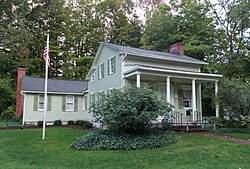Millard Fillmore
Millard Fillmore (January 7, 1800 – March 8, 1874) was the 13th president of the United States. He was president from 1850 to 1853. He was the last Whig president and the last president who was not a Democrat or Republican.
Millard Fillmore | |
|---|---|
 Portrait c. 1855–1865 | |
| 13th President of the United States | |
| In office July 9, 1850 – March 4, 1853 | |
| Vice President | None[a] |
| Preceded by | Zachary Taylor |
| Succeeded by | Franklin Pierce |
| 12th Vice President of the United States | |
| In office March 4, 1849 – July 9, 1850 | |
| President | Zachary Taylor |
| Preceded by | George M. Dallas |
| Succeeded by | William R. King |
| 14th Comptroller of New York | |
| In office January 1, 1848 – February 20, 1849 | |
| Governor | |
| Preceded by | Azariah C. Flagg |
| Succeeded by | Washington Hunt |
| Chairman of the House Ways and Means Committee | |
| In office March 4, 1841 – March 3, 1843 | |
| Preceded by | John Winston Jones |
| Succeeded by | James I. McKay |
| Member of the U.S. House of Representatives from New York's 32nd district | |
| In office March 4, 1837 – March 3, 1843 | |
| Preceded by | Thomas C. Love |
| Succeeded by | William A. Moseley |
| In office March 4, 1833 – March 3, 1835 | |
| Preceded by | Constituency established |
| Succeeded by | Thomas C. Love |
| Personal details | |
| Born | January 7, 1800 Moravia, New York, U.S. |
| Died | March 8, 1874 (aged 74) Buffalo, New York, U.S. |
| Resting place | Forest Lawn Cemetery, Buffalo |
| Political party |
|
| Spouse(s) | |
| Children | |
| Father | Nathaniel Fillmore |
| Occupation |
|
| Signature | |
| Military service | |
| Branch/service | |
| Years of service |
|
| Rank | |
| Commands | Union Continentals (Guard) |
| Battles/wars | American Civil War |
Fillmore became president in 1850, when Zachary Taylor, the previous president, died. The Whigs did not pick him to run for president in 1852. He ran for president in 1856 for the Know-Nothing Party but lost.
Early life
Millard Fillmore grew up in a poor family.[1] He worked hard to do well in school and go to college. He got a job as a lawyer in 1823. In 1828, he was voted to be part of the New York State Assembly and made friends in the Whig Party, which helped him get chosen to run for vice president in 1848.
Presidency
When he was vice president, Fillmore was in charge of the U.S. Senate while it was fighting over a decision about slavery involving Texas and New Mexico.
When he became president, the slavery issue was very intense to the point that the southern states were close to leaving the United States.
Fillmore signed the Compromise of 1850, five laws to calm down the slavery issue by pleasing both the northern states and the southern states. Although the Compromise of 1850 made the states get along, the peace did not last forever. In the late 1850s, the North and the South stopped getting along.
He personally fought a fire at the Library of Congress in December 1851. He then signed a bill to fund the replacement of all the books that were destroyed in the fire.[2]
California was made the 31st U.S. state on September 9, 1850.
His decision to sign the Compromise of 1850 made many of the people in his Whig Party upset at him. They refused to let him run president in 1852.
He started the first library at the White House.[3]
After being president
To repalce Fillmore, Franklin Pierce became the 14th president. Fillmore got a job in charge of the University of Buffalo. Fillmore joined the Know-Nothing Party and ran for president again in 1856, but he lost and came behind both the Democrat and the Republican candidates. He died in Buffalo, New York, of a stroke at the age of 74.
There is a statue of Fillmore at City Hall in Buffalo.
Millard Fillmore Media
Millard Fillmore helped build this house in East Aurora, New York, and lived there from 1826 to 1830.
Taylor (left) – Fillmore campaign banner by Nathaniel Currier
Fillmore photographed in 1849 by Mathew Brady
From a Peter F. Rothermel engraving: Vice President Fillmore (upper right) presides over the Compromise debates as Henry Clay takes the floor of the Old Senate Chamber. John C. Calhoun (seen in part standing just to Fillmore's right) and Daniel Webster (seated to the left of Clay) look on.
Official portrait of Fillmore by George Peter Alexander Healy, c. 1857
Notes
- ↑ Fillmore was Vice President under President Zachary Taylor and became President upon Taylor's death on July 9, 1850. Prior to adoption of the Twenty-fifth Amendment (1967) a vacancy in the office of vice president was not filled until the next ensuing election and inauguration.
References
- ↑ "American President: Millard Fillmore". Archived from the original on 2008-04-20. Retrieved 2012-12-28.
- ↑ "10 Things You Should Know About Millard Fillmore". History. Retrieved December 16, 2024.
- ↑ "Fillmore's Foundation". loc.gov. Retrieved November 4, 2013.









